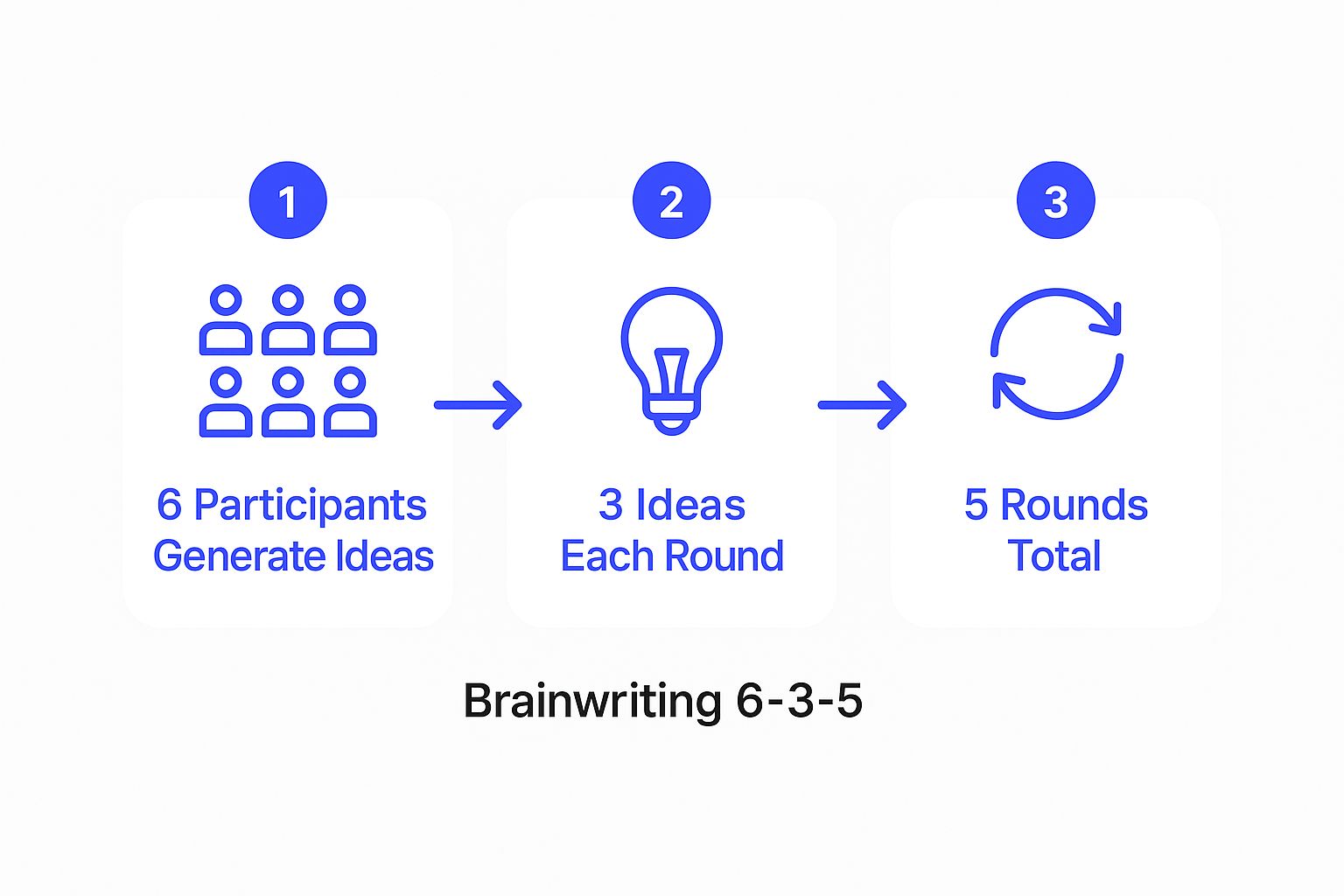Picture this: you get 108 ideas from your team in just 30 minutes. The best part? It happens in complete silence. That's the power of the brainwriting 6-3-5 method. It’s a structured, quiet technique designed to get the most creative juice from your team while making sure every single person gets to contribute.
What Is Brainwriting 6-3-5 and How Does It Work?

Let's be honest, traditional brainstorming sessions can easily go off the rails. The loudest voices often take over, while the quieter folks—who might have the most brilliant ideas—never get a chance to speak up. This often leads to groupthink and a disappointingly narrow set of solutions.
Brainwriting 6-3-5 completely sidesteps this problem. It intentionally removes all verbal discussion from the initial idea-generating stage. The name itself is a neat little recipe for the process: 6 participants are asked to write down 3 ideas, with 5 minutes for each round.
Instead of a chaotic free-for-all, this method gives you a clear, structured runway for creativity. It forces a quick-fire round of ideas in short, focused bursts, ensuring everyone is involved.
The Power of the Formula
The real magic of brainwriting 6-3-5 is how it builds on itself. After the first five-minute round, everyone passes their idea sheet to the person next to them. In the next five-minute block, you use the ideas you just received as a springboard to come up with three new ones. This cycle repeats for a total of six rounds.
The format is simple but incredibly effective: 6 participants generating 3 ideas each, across 6 rounds of 5 minutes, equals a stunning 108 ideas in half an hour. The process naturally levels the playing field, preventing dominant personalities from steering the ship.
This structured passing and building ensures that ideas don't just get listed; they get combined, expanded, and evolved. It's a chain reaction of collaborative innovation that pushes your team to think beyond the most obvious, surface-level solutions.
To give you a quick reference, here's a simple breakdown of how the 6-3-5 method works.
Brainwriting 6-3-5 At a Glance
| Component | What It Means | Purpose |
|---|---|---|
| 6 Participants | The ideal group size for one session. | Keeps the process manageable and ensures a diverse pool of initial ideas. |
| 3 Ideas | Each person writes down three ideas per round. | Forces concise thinking and prevents over-analysis, encouraging quantity. |
| 5 Minutes | The time limit for each round of idea generation. | Creates a sense of urgency and maintains a high-energy, focused pace. |
This table shows just how simple the core mechanics are. The structure does the heavy lifting, allowing creativity to flow freely from everyone involved.
Of course, the 6-3-5 technique is just one powerful tool. Exploring other innovative ways to spark creativity can help you build a well-rounded ideation toolkit for any challenge. To learn more about the broader concept, you can check out our high-level guide explaining what brainwriting is and how this silent but effective approach works.
Your Step-by-Step Guide to a 6-3-5 Session
Alright, you get the what and the why of Brainwriting 6-3-5. Now for the fun part: the how. Running a session is surprisingly simple when you have a good game plan. Think of this guide as your playbook, breaking down every phase into clear, actionable steps.
Your role here is like a director of a silent film. You set the stage, provide clear directions, and then let the process work its magic. The goal is to capture every spark of creativity without anyone saying a single word.
Step 1: Get Everything Ready
A little prep work before your team gets together makes all the difference. Your most important job is to nail down a clear and focused problem statement. This isn't the time for fuzzy goals. You need a statement that’s specific enough to point people in the right direction but open enough to let creativity flow.
For instance, instead of a vague goal like "Improve our app," try something like, "How can we get users to engage with our app's main features every day?" See the difference? That focus is exactly what your team needs.
Once you’ve got the problem statement, it's time to gather your crew and materials:
- Participants: Aim for a group of six people. The real magic happens when you bring together diverse backgrounds and perspectives.
- Worksheets: You'll need a simple grid with six rows and three columns for each person. This can be a physical handout or a digital template.
- Timer: Keep a visible timer handy to hold each round to a strict five minutes.
If your team is spread out, the right digital tools are your best friend. You can find some fantastic templates in many brainstorming tools online that make running a 6-3-5 session remotely a total breeze.
Step 2: Run the Ideation Rounds
With everyone set, it’s go-time. The silent ideation begins now. As the facilitator, you just need to manage the clock and make sure everyone sticks to the golden rule: absolutely no talking.
This visual shows you the simple, repeating flow of the session.

As you can see, the structured rotation is key. It guarantees that every single person contributes and builds on what others have started.
Here’s the play-by-play:
- Round 1 (5 Minutes): Each of the six participants silently jots down three ideas in the top row of their worksheet.
- Pass the Sheet: When the five minutes are up, everyone passes their sheet to the person on their right (or follows a set digital sequence).
- Round 2 (5 Minutes): Now, each person reads the ideas they just received. Using those as a jumping-off point, they add three new ideas to the second row.
- Repeat: You'll keep this pass-and-add process going for a total of six rounds.
The entire idea-generating part takes just 30 minutes. When you're done, you'll be sitting on six worksheets, each filled with 18 ideas. That's a grand total of 108 raw ideas. Not bad for half an hour!
Step 3: Pull It All Together and Talk
Once the 30 minutes are up, the silence is broken. Collect all the worksheets and get ready to talk. The final step is to group similar ideas, discuss the possibilities, and start sorting through the list as a team. This is where you pan for gold, sifting through the huge quantity of ideas to find the gems that can be polished into real, workable solutions.
Why Silent Ideation Unlocks Better Ideas

Let’s be honest: traditional brainstorming sessions often don't work as well as we'd hope. It usually takes just one or two assertive people to steer the entire conversation, a problem known as production blocking. When one person is talking, everyone else is listening—not thinking of their own unique ideas. The flow of creativity from the rest of the team grinds to a halt.
Brainwriting 6-3-5 gets around this beautifully. By making the initial idea generation silent and structured, it lets everyone think and write at the same time. No more waiting for a turn to speak or having a great idea derailed by someone else’s tangent. It’s a far more efficient way to make sure no good idea gets lost in the noise.
There’s also the very human fear of sounding silly, or evaluation apprehension. How many times have you held back an idea because you worried what your boss or colleagues might think? This anxiety pushes us toward safe, predictable concepts and away from the truly innovative ones we’re after.
Fostering Psychological Safety and Inclusivity
The genius of Brainwriting 6-3-5 lies in the psychological safety it creates. When you’re just passing worksheets, the ideas are judged on their own merit, not on who came up with them. This is incredibly freeing, especially for introverts or more junior team members who might not feel comfortable shouting over the louder voices in the room.
This method is naturally democratic. It’s not about who’s the fastest talker or the most confident presenter. It’s about giving everyone a quiet, focused space to contribute their unique point of view. What you get is a much richer pool of ideas that taps into the whole team's brainpower, not just the most outspoken members. To explore this further, check out our guide on other creative problem solving methods.
The Power of Positive Pressure
That five-minute time limit for each round isn't just a random number. It’s a smart constraint that applies just the right amount of creative pressure. This short, intense burst of focus forces you to move past the obvious answers and dig for more original thoughts.
By preventing you from overthinking or trying to craft the "perfect" idea, the ticking clock actually helps you get into a state of creative flow. The goal becomes getting three ideas on paper—any three ideas—which often leads to surprisingly brilliant results.
This structured pressure is one of the secrets to its success. It’s a great example of the kind of active learning strategies that turn a passive meeting into a genuinely engaging sprint.
In the end, the silence isn't a bug; it's a feature. By sidestepping the common traps of group brainstorming, the Brainwriting 6-3-5 method ensures the ideas you generate are a true reflection of your team’s full creative potential.
How To Run a Brainwriting Session With Remote Teams
Great ideas don't care about geography. The great thing about Brainwriting 6-3-5 is that its structured format is practically built for remote and hybrid teams. The core process stays the same; you’re just swapping paper for pixels.
Instead of passing a physical worksheet around a table, you'll be using a shared digital space. Think of tools like Miro or Mural as your virtual conference room table. They’re perfect for creating a canvas where everyone can see and add ideas in real time. If you want to keep it simple, a shared Google Doc or Sheet can also work beautifully—just create a grid that looks like the paper version.
The goal is to digitally mimic the act of passing the paper. Each person gets their own dedicated section on the board, and when the timer for a round goes off, they simply move over to the next person's space to build on what's already there.
In-Person vs. Remote Brainwriting 6-3-5
While the core principles remain the same, the execution of Brainwriting 6-3-5 naturally changes when you move from a physical room to a digital one. The table below breaks down the key differences in how the technique works in each environment.
| Feature | In-Person Session | Remote/Digital Session |
|---|---|---|
| Medium | Pen and paper worksheets. | Digital whiteboards (Miro, Mural) or shared documents (Google Docs, Sheets). |
| Passing Ideas | Physically passing the paper to the person next to you. | Moving to the next participant's section or slide on a shared digital board. |
| Timing | A facilitator uses a physical timer or stopwatch in the room. | The facilitator uses a timer on the video call or sets automated deadlines. |
| Communication | Non-verbal cues are visible. Facilitator provides live instructions. | Primarily through chat or video call. Clear initial instructions are critical. |
| Flexibility | Limited to a single, synchronous session where everyone is present. | Can be run synchronously (live) or asynchronously (over a set period). |
The transition to a digital format actually adds a layer of flexibility, especially for teams spread across different locations and time zones.
Choosing Your Session Format
When you take Brainwriting 6-3-5 online, you’ve got two main ways to run it: live or on your own time. The best choice really comes down to what works for your team’s schedule.
- Synchronous Session: This is the live version. Everyone hops on a video call together. The facilitator shares the digital whiteboard, walks everyone through the rules, and acts as the official timekeeper. This format keeps the energy and focused pressure of an in-person meeting.
- Asynchronous Session: Here, the facilitator sets up the digital template and gives the team a much wider window to contribute—say, 24 or 48 hours. People can add their ideas whenever it suits them, which is a lifesaver for teams in different time zones.
Of course, making this work remotely is about more than just picking the right tool. Solid virtual meeting best practices are crucial for keeping everyone focused and on the same page.
Setting Up a Digital Template
Your digital template is the most important piece of the puzzle. Here’s a quick guide to getting it right:
- Create a Central Board: Start with a single, shared board or document. The first thing everyone should see is the problem statement, written clearly at the top.
- Make Individual Sections: Carve out six separate areas, one for each participant. Label them with names so there’s no confusion about whose space is whose.
- Build the Grid: Inside each person's section, create a simple grid. You'll need six rows (one for each round) and three columns (one for each idea).
The move to remote work has really put this technique to the test, and it has passed with flying colors. Researchers have even built specific online tools just for the 6-3-5 method, showing how well it adapts for distributed teams. You can read the full research about this digital design tool and see how it was used in real-world learning environments.
This kind of structured digital setup keeps the process moving smoothly and fairly. It's just one of many powerful methods out there, and you can find more in our guide to effective remote brainstorming. With a few simple digital tweaks, your team can start generating a huge volume of ideas, no matter where they log in from.
Best Practices for Facilitating Your Session

Knowing the rules of brainwriting 6-3-5 is one thing, but actually leading a session is where the magic happens. A great facilitator does more than just watch the clock; they create an environment where creativity can actually take off. And that work starts well before the first idea is ever written down.
The most critical piece of prep work? Framing the problem. If you kick things off with a vague prompt like "new marketing ideas," you'll get vague, uninspired answers. Be specific. A prompt like, "How can we increase free trial sign-ups by 20% in the next quarter?" gives the team a clear, concrete target to aim for.
Just as important is who you put in the room. If you gather six people with the same job and background, you're going to get a lot of the same ideas. Instead, build a team with diverse viewpoints. Mix your engineers with your marketers, and your seasoned veterans with your newest hires, to get a truly rich pool of concepts.
Your Pre-Session Checklist
Walking into a session unprepared is the fastest way to kill the creative vibe. A smooth setup means no interruptions, which keeps the energy and focus high. A good brainstorming session template can also give you a great head start on your planning.
- Finalize the Problem Statement: Write it down where everyone can see it—at the top of each worksheet or digital board.
- Prepare Your Materials: Have the 6-3-5 worksheets printed or ready to go on a digital whiteboard like Miro or Mural.
- Set the Timer: Make sure everyone can see the clock. The sense of urgency is part of what makes this work.
- Brief the Team: Give everyone a quick heads-up about the process, especially the "no talking" part. This ensures they know what to expect.
Guiding the Session in Real-Time
Once the timer starts, your job is to protect the process. The "no talking" rule is the cornerstone of this method. It's what prevents groupthink and gives everyone, especially the introverts, an equal voice.
If someone starts talking, gently nudge them back to writing and save the discussion for later. Be a firm but friendly timekeeper, clearly announcing the start and end of each five-minute round. It’s also totally normal if someone gets stuck. Remind them that a simple phrase or even a quick sketch is fine. This is about quantity, not polished perfection.
The facilitator's role isn't to generate ideas, but to protect the environment where ideas can be generated freely and without judgment. Your quiet, steady presence allows the structured process to do its work.
After the Final Round
Once the 30 minutes are up and you have 108 raw ideas, your role shifts from guardian to guide. Now, it's time to turn all that silent work into a collaborative discussion.
- Cluster Similar Ideas: Start grouping concepts that feel related. This helps you spot the emerging themes.
- Clean Up the List: Pull out any exact duplicates to make the list easier to manage.
- Discuss and Prioritize: Now, open the floor for discussion. Have the group vote on the most promising ideas or clusters.
- Decide on Next Steps: Don't let the momentum die. End the meeting by assigning clear action items to make sure the best ideas actually go somewhere.
This last part is what turns a fun creative exercise into a real, actionable plan for your team.
Common Questions About Brainwriting 6-3-5
https://www.youtube.com/embed/yg9Svx9zkzw
Brainwriting 6-3-5 is powerful because of its structure, but that same structure can make it feel a bit rigid. People often worry about what to do when their session doesn't follow the rules perfectly. Don't sweat it. The method is more flexible than it sounds.
Let's walk through some of the most common "what if" scenarios you'll likely run into. Knowing how to handle these will help you lead a session with confidence, no matter what surprises pop up.
Adapting the Group Size
One of the first things people ask is about the magic number six. What if you have four people? Or maybe eight? While six participants is the sweet spot for generating a whopping 108 ideas, you can absolutely make it work with different numbers.
- Fewer than six people: No problem at all. The process works just fine. With four participants, for instance, you'll still walk away with a very respectable 72 ideas (4 people x 3 ideas x 6 rounds). The core principle of quiet, round-robin idea building stays exactly the same.
- More than six people: You could try running one massive session, but things can get chaotic quickly. A much better way to handle a larger group is to split them into smaller teams of four to six. This keeps the energy focused and the process manageable for everyone involved.
The real goal is to keep the ideas flowing from person to person, not to get hung up on a specific headcount.
Dealing with Creative Blocks
It’s round four, the timer is ticking, and someone’s mind goes completely blank. It happens to the best of us. So what should a participant do if they just can't think of three new ideas?
The point of brainwriting 6-3-5 isn’t to come up with three flawless, groundbreaking ideas every single round. It’s all about maintaining momentum and using what others wrote as a springboard.
If someone gets stuck, here are a few things they can try:
- Rephrase an existing idea: Look at the ideas just passed to them and simply try to say one in a different way.
- Combine two previous ideas: Can two concepts on the worksheet be mashed together to create something new?
- Draw a picture or a symbol: Ideas don't always have to be words. A quick sketch is a great contribution and can often trigger a totally fresh perspective for the next person who sees it.
The most important thing is to just write something down. Anything. This keeps the creative ball rolling and stops people from overthinking it.
Ready to make your brainstorming sessions truly effective, even with a remote team? Bulby provides guided, AI-powered exercises that turn chaotic meetings into focused, productive ideation. Our platform ensures every voice is heard, leading to better, more creative solutions. See how Bulby can transform your team's creativity at https://www.bulby.com.

